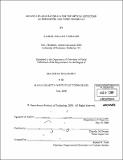| dc.contributor.advisor | Timothy M. Swager. | en_US |
| dc.contributor.author | Thomas, Samuel William, III | en_US |
| dc.contributor.other | Massachusetts Institute of Technology. Dept. of Chemistry. | en_US |
| dc.date.accessioned | 2007-02-21T13:16:50Z | |
| dc.date.available | 2007-02-21T13:16:50Z | |
| dc.date.copyright | 2006 | en_US |
| dc.date.issued | 2006 | en_US |
| dc.identifier.uri | http://hdl.handle.net/1721.1/36260 | |
| dc.description | Thesis (Ph. D.)--Massachusetts Institute of Technology, Dept. of Chemistry, 2006. | en_US |
| dc.description | Vita. | en_US |
| dc.description | Includes bibliographical references. | en_US |
| dc.description.abstract | Optical chemosensing, especially using amplifying fluorescent polymers, can allow for the highly sensitive and selective vapor-phase detection of both explosives and highly toxic chemicals, including chemical warfare agents. There are varieties of analyte targets, however, that remain challenging for detection by these methods. Research towards improving this technology has obvious implications for homeland security and soldier survivability. This dissertation details the development of new molecules, materials, and transduction schemes aimed at improving both the versatility and sensitivity of optical chemical detection. Chapter One provides an introduction to the field of fluorescent polymer sensors, principally focusing on their utility in the detection of nitroaromatic explosives. Brief descriptions of other analytical methods used for explosives detection are also included. Chapter Two describes the synthesis and optical properties of a new class of conjugated polymers that contain alkyl-amino groups directly bound to the arene rings of poly(phenylene ethynylene)s and poly(fluorene)s. These materials displayed red-shifted absorption and emission spectra, large Stokes Shifts, as well as long excited state lifetimes. | en_US |
| dc.description.abstract | (cont.) Also described is the use of films of these readily oxidized polymers in the vapor-phase detection of hydrazine down to a concentration of 100 parts-per-billion. This new scheme for the detection of hydrazine vapor relies on the analyte's reduction of oxidized traps ("unquenching") within the polymer film to give a fluorescence "turn-on" signal. Chapter Three begins with an introduction to the various classes of explosive molecules, as well as to the concept of "tagging" plastic explosives with higher vapor pressure dopants in order to make them easier to detect. This is followed by a description of how the taggant DMNB was successfully detected using high band-gap poly(fluorene)s. The higher energy conduction bands of these materials allowed for exergonic electron transfer to DMNB and fluorescence quenching in both the solution and solid states. Phosphorescence is the theme of Chapter Four, in which two research projects based on highly phosphorescent cyclometalated Pt(II) complexes are summarized. This includes the synthesis and optical characterization of a phosphorescent poly(fluorene), one of the repeat units of which is a Pt(ppy)(acac)-type complex. Comparisons of its intrinsic photophysical properties and oxygen-induced quenching behavior to model compounds are also summarized. | en_US |
| dc.description.abstract | (cont.) Chapter Four also details investigations into using oxidative addition reactions of new bis-cyclometalated Pt(II) complexes for the dark-field turn-on chemical detection of cyanogen halides. Incorporating substituents on the ligands that force steric crowding in the square plane accelerated the addition of cyanogen bromide to these complexes, which also correlated with the room-temperature phosphorescence efficiency of these complexes. Exposure of polymer films doped with these complexes gave a dark-field turn on signal to the blue of the reactant that corresponded to the phosphorescence of the Pt(IV) oxidative addition product. Finally, Chapter Five focuses on iptycenes, a very useful structural moiety in the field of optical chemosensing. The development of an improved synthetic procedure for the preparation of the iptycene group is described. This procedure has been showed to be effective in the preparation of a series of new iptycene-containing molecules, including a poly(iptycene). To conclude, the unique counter-aspect ratio alignment behavior of a poly(iptycene) in a stretch-aligned polymer film is summarized. This is rationalized by a "threading" model, in which the chains of the poly(vinyl chloride) matrix occupy the internal-free-volume defined by the poly(iptycene). | en_US |
| dc.description.statementofresponsibility | by Samuel William Thomas, III. | en_US |
| dc.format.extent | 268 p. | en_US |
| dc.language.iso | eng | en_US |
| dc.publisher | Massachusetts Institute of Technology | en_US |
| dc.rights | M.I.T. theses are protected by copyright. They may be viewed from this source for any purpose, but reproduction or distribution in any format is prohibited without written permission. See provided URL for inquiries about permission. | en_US |
| dc.rights.uri | http://dspace.mit.edu/handle/1721.1/7582 | |
| dc.subject | Chemistry. | en_US |
| dc.title | Molecules and materials for the optical detection of explosives and toxic chemicals | en_US |
| dc.type | Thesis | en_US |
| dc.description.degree | Ph.D. | en_US |
| dc.contributor.department | Massachusetts Institute of Technology. Department of Chemistry | |
| dc.identifier.oclc | 77461602 | en_US |
